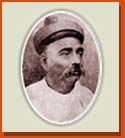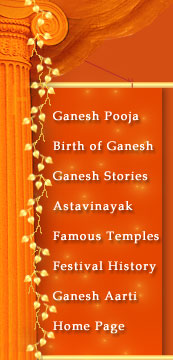|
|
|
|

Ganesh History,
Ganesha History, Ganpati History,
History behind Ganesh Chaturthi, History behind Ganeshotsav,
History behind Ganesh Festival, Lokmanya Tilak, Ganesh Festival
History
|
|
|
|

Origin
of the Ganpati Festival
This colourful festival is a very Maharashtrian one, which
is celebrated with great gusto. In fact it is the most popular
festival in the State. There are several reasons for this.
Ganpati is after all a popular god. His blessings are invoked
at most religious ceremonies as he is the god who can remove
all obstacles to success. He is the giver of fortune and
can help to avoid natural calamities. He is also the god
who brings prosperity.
Ganpati, the god of wisdom and the benevolent deity of the
dynasty of Peshwas who ruled Maharashtra inculcating a special
culture in the state. Ganpati is the herald of auspicious
beginnings and is the beloved deity of all Maharashtrians.
The Ganeshutsav was celebrated at the houses of leading
Sardar families like Patwardhan, Mujumdar, Khasgiwale etc.
In 1893, Sardar Nanasaheb Khasgiwale for the first time
celebrated the utsav as a public festival and that year
Ghotawdekar, Kasgiwale and Bhau Rangari these three Savajanik
Ganesh utsav's were celebrated and for the first time There
was a procession also taken out on the roads. The well known
freedom fighter and statesman, Lokmanya
Bal Gangadhar Tilak, saw in the festival a
way of uniting people in a common cause and in this manner
a possible means of bringing about political consciousness
under the guise of a religious celebration, with freedom
for India being the ultimate goal. Lokmanya Tilak also started
celebrating Ganesutsav as a public festival by establishing
a Sarvajanik Ganpati at Vinchurkarwada in 1894 and today
it is the most popular event in the State. It was a unique
move by this freedom fighter, which he achieved with the
Ganpati Visarjana or immersion procession which is taken
out on the final day of the ganesh festival.
The ten-day festival starts from the fourth day of the bright
half of the lunar month, Bhadrapada and continues till the
fourteenth day. Thousands join in and form the many processions
that fill the streets when the time comes for the image
to be immersed in water...the sea, river or lake. The festival
brings with it a feeling of comradeship. Everyone wants
to participate.
On the first day the clay form of Ganpati
is brought home with great devotion. Prayers are said and
songs chanted to the accompaniment of music from the mridanga
or two-sided drum and the jhanj or cymbals. Some devotees
select and buy their Ganpati on the same day and others
place their orders months in advance. The figures are often
very large, standing several metres high. These larger Ganesh
images are usually ordered by neighbourhood puja committees,
the entire neighbourhood contributing towards the purchase.
After the Ganpati image is collected it is ceremoniously
installed in a place of honour and various rituals take
place. The Ganpati is decorated with ornaments, flowers
and lights. Puja and aarti are performed every morning and
evening using flowers, rice, betel nuts and leaves, turmeric,
red powder, coins and oil lamps. Men and women, the old
and young all join in.Special sweets called modaks are steamed
or fried for offering to Ganpati. Modaks are small rice
or wheat flour dumplings stuffed with coconut and jaggery.
These are served at the festive meals during the festival.
Additionally, a large variety of savoury and sweet snacks
such as karanjis, ladoos, chaklis, kadbolis and anarsas
are distributed to devotees and guests during the pujas.
On the tenth day of the festival this happy
loving god leaves for his celestial home and is immersed
in water. Huge processions made up of different groups all
accompanying the image of Ganpati that they have worshipped,
make their way by foot to the immersion site. The very large
images are transported by truck. All this is done to the
accompaniment of dancing and singing. The mood is jovial
with everyone chanting, over and over again, "Ganapati
Bappa Morya, Pudhchya Varshi Lavakar Yaa..."
calling Ganpati to come again soon next year.
The sight of the crowded streets, the different Ganesh images
and the happy people is an amazing spectacle. In large towns
special roads are demarcated for these processions and the
traffic police and users of cars, buses and two-wheelers
display notable patience with the crowds and never-ending
processions.
However, it is the stupendous scale of this festival, celebrated
by communities of people in the cities and villages of Maharashtra,
which attracts millions of people to the state. Some of
the community idols are as tall as 20 metres. These are
set up in large pandals, worshipped for 10 days and then
taken to the sea in immense processions for immersion. Not
only are the massive idols the attraction of the festival,
the plays, musical soirees, contests of skill, bullock cart
races, swimming galas -all of which are planned in different
venues -are events which show the enthusiasm of the people.
Undoubtedly, Maharashtrians love Ganpati.

|

|
|

